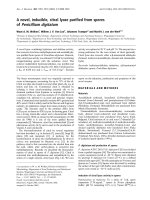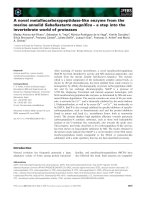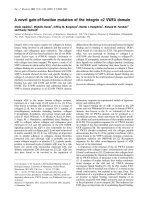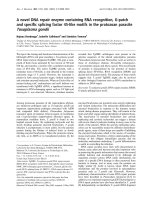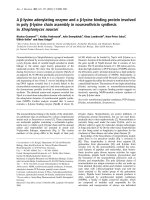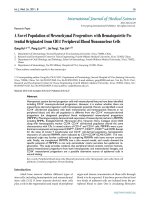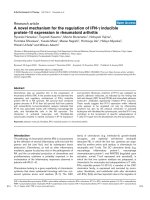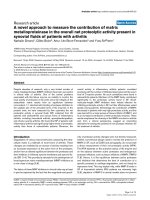Báo cáo Y học: A novel DNA repair enzyme containing RNA recognition, G-patch and specific splicing factor 45-like motifs in the protozoan parasite Toxoplasma gondii potx
Bạn đang xem bản rút gọn của tài liệu. Xem và tải ngay bản đầy đủ của tài liệu tại đây (458.53 KB, 9 trang )
A novel DNA repair enzyme containing RNA recognition, G-patch
and specific splicing factor 45-like motifs in the protozoan parasite
Toxoplasma gondii
Najoua Dendouga
1
, Isabelle Callebaut
2
and Stanislas Tomavo
1
1
Equipe de Parasitologie Mole
´
culaire, Laboratoire de Chimie Biologique, CNRS UMR 8576, Universite
´
des Sciences et Technologies
de Lille, France;
2
Equipe Syste
`
mes Mole
´
culaires et Biologie Structurale, Laboratoire de Mine
´
ralogie-Cristallographie,
CNRS UMR 7590, Universite
´
Paris, France
We report the cloning and functional charaterization of the
full-length cDNA and gene encoding a Toxoplasma gondii
DNA repair enzyme designated TgDRE. The gene is com-
posed of three exons separated by two introns of 780 and
630 bp, and encodes a protein with a predicted molecular
mass of 49.6 kDa. The native TgDRE protein, with a
molecular mass of 60 kDa, is only detected in the virulent
tachyzoite stage of T. gondii. However, the transcript is
present in both asexual parasite stages, virulent tachyzoite
and avirulent encysted bradyzoite. When an Escherichia coli
mutant lacking ruvC endonuclease and recG helicase was
transformed with TgDRE cDNA, a significant increase in
resistance to DNA-damaging agents, such as UV light and
mitomycin C, was observed. Moreover, database searches
revealed that TgDRE orthologues were present in the
genome sequences of the related apicomplexa parasites
Plasmodium falciparum and Plasmodium yoelii,aswellasin
those of Arabidopsis thaliana, Drosophila melanogaster,
Caenorhabditis elegans and Homo sapiens. This novel family
of proteins is characterized by the presence of human
splicing factor SF45-like, RNA recognition (RRM) and
glycine-rich (G-patch) motifs. The presence of these motifs
suggests that T. gondii TgDRE might also be involved
in other biological functions such as RNA metabolism in
addition to DNA-repair.
Keywords: Toxoplasma gondii; DNA repair enzyme; RRM;
G-patch; splicing factor motif.
Among protozoan parasites of the Apicomplexa phylum,
are numerous pathogens such as Toxoplasma gondii (an
important opportunistic pathogen associated with AIDS
and congenital birth defects), Plasmodium falciparum
(causative agent of malaria), Eimeria (agent of coccidiosis)
and Cryptosporidium (opportunistic intestinal agent). In
mammalian nonfeline hosts, T. gondii is found in two
haploid asexual forms, the replicating tachyzoite and the
slowly dividing quiescent encysted bradyzoites. T. gondii
infection is asymptomatic in most adults, but the parasite
persists during the lifetime of infected hosts as slowly
dividing encysted bradyzoites. When the protective immu-
nity fails, as in AIDS or in transplanted patients [1], the
encysted bradyzoites can transform into actively replicating
and virulent tachyzoites. The tachyzoites differentiate into
encysted bradyzoites in response to the immune system
attack during disease progression. They will remain in the
brain and other organs during the lifetime of infected hosts.
The reactivation of encysted bradyzoites into actively
replicating and cytolytic tachyzoites can trigger a disease
with severe clinical syndromes leading in many cases to the
death of the patients. While the actively replicating tachy-
zoites can be successfully treated by different chemothera-
peutic agents, none of these drugs are capable of inhibiting
the encysted bradyzoites which is the source of toxoplas-
mosis reactivation. Therefore, a better understanding of the
biology of this obligate intracellular parasite and the
molecular mechanisms underlying T. gondii differentiation
is useful in controlling the infection.
DNA repair proteins have been well characterized in
human, yeast, plant and bacteria and play important roles
in preserving the genetic information that ensure the normal
cellular function and development [2–4]. Although all
organisms contain various DNA repair mechanisms, the
repair of a specific DNA damage is often conserved from
bacteria to human, and in many cases the proteins are
highly similar [5]. Little is known about DNA repair
mechanisms and the proteins involved in apicomplexan
parasites such as T. gondii and Plasmodia. However,
preliminary characterization of some DNA repair proteins
have been described in Plasmodium falciparum [6,7]. In
addition, two expressed sequence tags (EST) homologous to
DNA repair proteins have also been identified in T. gondii
[8]. Independently, we identified a T. gondii cDNA fragment
Correspondence to S. Tomavo, Equipe de Parasitologie Mole
´
culaire,
Laboratoire de Chimie Biologique, CNRS UMR 8576,
B
aatiment C9, Universite
´
des Sciences et Technologies de Lille,
59655 Villeneuve d’Ascq, France.
Fax: + 33 3 20 43 65 55, Tel.: + 33 3 20 43 69 41,
E-mail:
Abbreviations:TgDRE,Toxoplasma gondii DNA repair enzyme;
RRM, RNA recognition motif; HCA, hydrophobic cluster analysis;
MMC, DNA-damaging agent mitomycin C; G-patch, glycine rich
motif; SF45, splicing factor 45; DRT111, DNA repair/tolerance 111
enzyme; EST, expressed sequence tag; IPTG, isopropyl thio-b-
D
-
galactoside.
Note: the nucleotide sequences reported in this paper has been
submittedtoGenBankwithaccessionnumbersAF402310
(genomic DNA) and AF402311 (cDNA).
(Received 19 March 2002, revised 2 May 2002, accepted 13 May 2002)
Eur. J. Biochem. 269, 3393–3401 (2002) Ó FEBS 2002 doi:10.1046/j.1432-1033.2002.02993.x
encoding a polypeptide homologous to the DNA repair
enzyme (DRT111) of Arabidopsis thaliana [9,10]. Here, we
report on the isolation of the gene locus, full-length cDNA
and the functional analysis of the corresponding protein of
T. gondii that displays strong similarities with the P. falci-
parum, P. yoelii and A. thaliana proteins. We demonstrate
that T. gondii DNA repair protein is capable of comple-
menting an Escherichia coli mutant lacking ruvC endonuc-
lease and recG helicase. In addition, analyses of primary
structure indicate that a T. gondii DNA repair protein,
designated TgDRE (Tg DNA repair enzyme) for consis-
tency with the Arabidopsis thaliana enzyme, belongs to a
large family of proteins containing RNA recognition motifs
(RRM), glycine-rich motifs (G-patch) and a specific motif
named SF45 because of its similarity to the human splicing
factor 45 protein, which was described as a component of
the spliceosome [11]. The presence of the two first motifs
suggests that TgDRE may also be involved in RNA
metabolism.
EXPERIMENTAL PROCEDURES
Parasite and host cell cultures
The T. gondii 76K strain was used throughout this study.
Tachyzoites were grown in human foreskin fibroblasts
(HFF) using Dulbecco’s modified Eagle’s medium (Bio-
whittaker) supplemented with 10% fetal bovine serum
(Dutscher), 2 m
M
glutamine (Sigma) and 0.05 mgÆmL
)1
gentamicin (Sigma).
Southern blotting, Library screening and sequencing
For Southern blots, genomic DNA was extracted from
T. gondii tachyzoites according to standard procedures
[12]. The specific probes for Southern blots were generated
using the PCR DIG labelling mix (Roche Diagnostics).
Detection was performed using the chemiluminescence
method (Roche Diagnostics). A T. gondii genomic library
(kindly provided by D. Roos, University of Pennsylvania,
Philadelphia, USA) constructed in lambda DASHII
vector (Stratagene) using DNA fragment obtained after
BamHI digestion was screened by plaque hybridization
using a 380-bp digoxigenin-labeled probe [9]. Two
fragments, 7000- and 1700-bp, were subcloned into
pBluescript-SK+ and sequenced using an ALFexpress
automated sequencer (Amersham Pharmacia Biotech).
Rapid amplification of cDNA ends (RACE) and sequencing
To obtain full-length cDNAs, a RACE-PCR technique was
performed using a Marathon cDNA Amplification Kit
(Clontech) with the adaptor primer 2 and specific oligonu-
cleotides N34AS 5¢-CTTCACCTGGAGGAGATTTCC
AAA-3¢ for 5¢ RACE and N34S 5¢-GGGAGGGTC
TCGGCGTCAACAAAC-3¢ for 3¢ RACE. Nested PCR
was performed using internal oligonucleotides S10 5¢-GT
CGAGATGTTGGTTGTCGGAGACC-3¢ for 5¢ RACE
and PR2AS 5¢-GACCGTTACCACTGATTGCGGCTG
3¢ for 3¢ RACE. The PCR products were cloned into the TA
cloning vector (Invitrogen) which were used to transform
E. coli strain DH5a cells. The purified plasmids were
sequenced as described above.
Measurement of mRNA levels
Total RNA was isolated from encysted bradyzoites, tach-
yzoites, uninfected mice brain cells and HFF cells, as
previously described [13,14]. cDNA was synthesized using
reverse transcriptase and serial dilutions of the cDNA were
used to amplify ORFs of T. gondii a-tubulin [15] or that of
TgDRE. Primers were as follows: a-tubulin 5¢-ATGAGAG
AGGTTATCAGCATC-3¢ and 5¢-TTAGTACTCGTCAC
CATAGCC-3¢; for TgDRE, 34S13 sens: 5¢-ATGCTGGA
CTCTCTCTACGGGGAT-3¢ and 34AS15 antisens: 5¢-TT
AGTCGAGGGGTTTGTCTGC-3¢. PCR products were
electrophoresed on agarose gels, stained with ethidium
bromide, scanned and quantified by densitometry using the
program
NIH IMAGE
( />Expression of glutathion
S
-transferase (GST)-TgDRE
fusion protein and immunological analysis
The cDNA fragment of TgDRE was cloned into the
expression vector pGEX-6P-3 (Pharmacia). After induc-
tion of transformed E. coli (BL21 strain) using isopro-
pylthio-b-
D
-galactoside, recombinant proteins were
purified on glutathione–Sepharose 4B column using
preScission
TM
protease, according to manufacturer’s
instructions (Pharmacia). Polyclonal antiserum was gen-
erated in Balb/c mice using the purified recombinant
protein. IgG specific to TgDRE was purified from this
antiserum by incubating the polyclonal antibodies to
recombinant TgDRE blotted onto nitrocellulose. After,
one hour of incubation at room temperature and washing
with NaCl/P
i
, the bound-IgG was eluted with 3.5
M
potassium thiocyanate (KSCN), dialyzed and stored at
)20 °C with 20% BSA. Western blots were performed
using the purified anti-TgDRE IgG diluted at 1 : 100 or
with a monoclonal antibody specific to T. gondii actin
diluted at 1 : 100 and rabbit secondary antibodies con-
jugated to peroxidase diluted at 1 : 10 000 followed by
cheminilescence detection.
Functional complementation in
E. coli
mutants lacking
ruvC endonuclease recG helicase
E. coli RuvC/RecG-deficient N3398 strain [16,17] and
AB1157 wild-type strain (generously provided by J.B Hays,
Oregon State University, USA) were transformed with the
pGEX-6P-3 containing the TgDRE ORF or pGEX-6P-3
alone. After isopropyl thio-b-
D
-galactoside (IPTG)-induc-
tion, the bacteria were plated onto Luria–Bertani plates
containing 0.1 lgÆmL
)1
of DNA-damaging agent mitomy-
cin C (MMC) and incubated at 30 °Cfor3days.The
transformed E. coli RuvC/RecG-deficient N3398 strain
and AB1157 wild-type strain were subjected to UV light
after IPTG-induction. All experiments were performed in
darkness and the plates were then incubated overnight at
30 °C.
Database searches and sequence analysis
Searches within nonredundant databases were performed
using
PSI
-
BLAST
[18] at NCBI. The Smart and Pfam
databases were searched using
RPS
-
BLAST
. Hydrophobic
clusteranalysis(HCA)wasalsousedinordertodetect
3394 N. Dendouga et al. (Eur. J. Biochem. 269) Ó FEBS 2002
distant but significant sequence similarities between the
members of the SF45 family [19].
RESULTS
Cloning of the gene encoding
T. gondii
DNA repair
protein
A 380-bp cDNA fragment encoding a putative DNA
repair protein (designated TgDRE) isolated from a
T. gondii subtractive library [9] was used to probe
Southern blots performed using genomic DNA digested
with several restriction enzymes. Figure 1A shows the blot
washed under stringent conditions. Most enzymes tested
gave a single band except those with a predicted internal
restriction site. The hybridization data is consistent with a
single copy TgDRE gene in the nuclear genome. In order
to determine TgDRE genomic organization, a T. gondii
genomic library was screened using the 380-bp cDNA
probe. Two BamHI-digested fragments of 7000- and 1700-
bp were isolated, subcloned and sequenced. The nucleo-
tide sequence analysis of the genomic DNA revealed the
presence of two introns and three exons, which was
confirmed by the isolation and sequencing of the full-
length TgDRE cDNA. The comparison of cDNA and
genomic DNA nucleotide sequences allowed the deter-
mination of the exact position of the two introns which
were 780- and 630-bp long (Fig. 1B). These introns
contained the typical GT/AG consensus splicing signal.
The excision of the two introns from the primary
transcript results in a mature TgDRE mRNA of
1401 nucleotides, which probably represents most, if not
all, of the entire full-length cDNA. This was confirmed by
the reconstruction of full-length cDNA achieved by 5¢ and
3¢ RACE, which gave a nucleotide sequence of 2002 bp
with an ORF of 1401 bp (nucleotides 325–1725). This
2002-bp cDNA contains a ORF of 1401 bp that encodes
a protein of 466 amino acids with a calculated molecular
mass of 49.6 kDa. In addition, RT-PCR performed with
primers encompassing the start and stop codons demon-
strates a predominant mRNA species of 1.4 kb
(Fig. 2A,B).
Fig. 1. Genomic organization of T. gondii TgDRE locus. (A) Southern blot analysis using genomic DNA from tachyzoites of T. gondii 76K strain
digested with several restriction enzymes indicated at the top. The blot was hybridized with a 380-bp DNA probe indicated by the letter P in (B).
(B) Genomic organization of TgDRE locus and its comparison with cDNA map revealed two introns designated i
1
and i
2
. Boxes correspond to
exons deduced from cDNAs sequences. The positions of the start and stop codons are indicated by an arrow and asterisk, respectively.
Fig. 2. Comparative analysis of TgDRE mRNA level in the two devel-
opmental stages of T. gondii. (A) Results of RT-PCR with the primers
corresponding to the full-length ORF of T. gondii TgDRE by using
total RNA from tachyzoites, T, and in vivo encysted bradyzoites (B),
RNA from uninfected human fibroblasts, H, or from naive mice brain
cells (C). H and C represent the negative controls. The quantity of
cDNA used corresponds to the equivalent of 10
4
parasites for both
tachyzoite and bradyzoite stages. RT-PCR were also performed by
using the tubulin primers used as positive controls. (B) Semi-quanti-
tative RT-PCR was used for the amplification of the ORFs of TgDRE
and the housekeeping gene a-tubulin using serial dilutions of cDNAs
prepared from tachyzoites and bradyzoites isolated from brain of
infected mice.
Ó FEBS 2002 A novel T. gondii DNA repair enzyme (Eur. J. Biochem. 269) 3395
Developmental expression of TgDRE gene measured
by RT-PCR
In order to determine the transcript level of TgDRE in
both virulent tachyzoite and avirulent encysted bradyzoite,
RT-PCR was performed. To ensure that equal quantities
of each mRNA were being compared, the amplification of
a-tubulin ORF was used as control (Fig. 2A,B). The
RT-PCR revealed a band of 1.4 kb corresponding to
TgDRE in both tachyzoite and bradyzoite stages of
T. gondii. The cloning and sequencing of this RT-PCR
product confirmed its identity. In addition, no RT-PCR
products could be amplified from the negative controls
corresponding to cDNA prepared from human and
uninfected mice brain cells (Fig. 2A, lanes H and C). It
appears that TgDRE transcript is slightly more predom-
inant in encysted bradyzoites than in tachyzoites. We used
semiquantitative RT-PCR to show that TgDRE transcript
in encysted bradyzoites represents twofold to threefold
higher level than that in tachyzoites as evaluated by
densitometry (Fig. 2B), suggesting that TgDRE gene is
either overexpressed at the transcriptional level or its
mRNA is more stable in encysted bradyzoites than in
tachyzoites of T. gondii.
Characterization of TgDRE protein expressed in the two
developmental stages of
T. gondii
To investigate whether these mRNA abundances increase
the expression of TgDRE protein, a GST fusion protein
consisting of amino-acid residues 1–466 of the ORF fused
to the C-terminus of the 30-kDa GST protein was
constructed. SDS/PAGE analysis of the IPTG-induced
E. coli revealed a predominant 90-kDa full-length protein
in both total SDS-lysate and sonicated soluble extract
(Fig. 3A, lanes 3 and 4). The size of this recombinant
fused protein appears higher in both total extract lysate
than expected (a difference of 10 kDa) from the apparent
molecular mass of 49.6 kDa predicted by TgDRE
primary structure plus the 30-kDa GST protein. The
recombinant TgDRE protein without the fused GST was
also obtained by affinity chromatography on a GST
column followed by the preScission protease digestion
(Fig. 3A, lane 5). Again, the pure recombinant TgDRE
migrated as a 55-kDa protein instead of the apparent
molecular mass of 50 kDa. One additional lower
molecular mass protein species is present in the purified
preparation. We believe this to be due to proteolytic
degradation of the 90-kDa protein as a result of
contaminating cellular proteases. The purified recombin-
ant protein was used to raise polyclonal antisera in mice.
The Western blot (Fig. 3A, lane 6) shows the strong
immunoreactivity of the affinity-purified IgG from the
polyclonal antiserum against the electroeluted pure
recombinant TgDRE of 55 kDa, demonstrating that a
specific anti-TgDRE serum was generated. However,
Western blots of this purified antiserum specific to
TgDRE revealed a faint specific native protein of
60 kDa in the tachyzoites (data not shown). This
60-kDa protein can be readily detected when 20- to
200-fold amount of proteins from tachyzoites were loaded
in the SDS/PAGE (Fig. 3B, lanes 1–3). It is interesting to
note that a native protein of 60-kDa was detected in the
parasite instead of 55-kDa as expected for the recombin-
ant protein (Fig. 3A, lanes 5 and 6). Because it is difficult
to obtain an equivalent amount of protein in encysted
bradyzoites, we were unable to identify the TgDRE
protein in this developmental parasite stage. We conclu-
ded that the higher level of transcript detected in RT-PCR
in encysted bradyzoites does not correspond to an
increased level of TgDRE protein, and that the protein
level is very low in the virulent tachyzoite. This conclusion
was supported by the control experiments where we
measured the quality/quantity of total protein extracts by
immunoblots using monoclonal antibodies directed
against actin, the tachyzoite-specific protein SAG1 and
the bradyzoite-specific antigen (data not shown). Collec-
tively, our data demonstrate that a 60-kDa protein can be
recognized by the anti-TgDRE IgG in the virulent
tachyzoite of T. gondii.
Fig. 3. Developmental expression of TgDRE protein in T. gondii. (A) SDS/PAGE analysis of the GST fusion recombinant TgDRE protein. Lane 1,
molecular mass markers; lane 2, total SDS lysate from uninduced E. coli containing the pGEX-6P-3 vector alone; lane 3, total SDS lysate of the
same E. coli containing pGEX-6P-3 vector with TgDRE ORF after induction by IPTG for 3 h; lane 4, soluble fraction obtained after centrifu-
gation of induced E. coli disrupted by sonication; lane 5, affinity purified recombinant TgDRE after cleavage with the preScission protease and
elution from the glutathione column; lane 6, immunoblot of anti-TgDRE serum against the purified specific recombinant TgDRE. (B) Western blot
analysis of protein extracts corresponding to 5 · 10
7
(1), 1 · 10
8
(2) and 6 · 10
8
(3) equivalent tachyzoites of T. gondii 76K strain.
3396 N. Dendouga et al. (Eur. J. Biochem. 269) Ó FEBS 2002
TgDRE cDNA is capable of functionally complementating
E. coli
mutant lacking ruvC endonuclease
and recG helicase
Similarity searches revealed that TgDRE displays signifi-
cant homology to DNA repair/toleration protein (DRT111)
of A. thaliana [10]. As the DRT111 protein was previously
shown to partially complement E. coli mutants lacking
RuvC and RecG helicase activities, we decided to investi-
gate whether TgDRE was capable of correcting these
activities in E. coli mutant phenotype. The transformation
of this E. coli mutant lacking RuvC and RecG enzyme
activities with the pGEX-6P-3 alone or pGEX containing
TgDRE ORF was performed in the presence of mitomycin
C. The in vivo effect of TgDRE activity on E. coli RuvC
–
RecG
–
revealed a significant increased resistance of trans-
formed mutants to the DNA-crosslinking agent mitomy-
cin C (Fig. 4). The resistance was increased by as much as
fourfold relative to mutants transformed with the pGEX
alone and treated with mitomycin C under the same
experimental conditions (Fig. 4). However, it appears that
TgDRE did not fully correct the mutant phenotype because
the surviving bacteria in the wild type E. coli is higher in the
presence of this chemical DNA-damaging agent (Fig. 4).
The partial correction of the E. coli mutant by TgDRE
cDNA is estimated at 40% less than that of the wild-type
bacteria in the presence of mitomycin C. In addition, we
also investigated whether TgDRE is capable of correcting
the DNA-damaging sensitive phenotype in the same E. coli
RuvC
–
RecG
–
mutant after UV light treatment because it
has been previously shown that this bacteria mutant is also
partially sensitive to this treatment. The transfection with
TgDRE cDNA also increased the resistance to UV light
treatment in this mutant as compared to that transformed
with the pGEX alone (data not shown). Taken together,
these data show convincingly that TgDRE cDNA encode a
functional DNA repair protein which can partially correct
the E. coli RuvC
–
RecG
–
-sensitive phenotype.
TgDRE belongs to a large family of proteins sharing
G-patch, RNA recognition motifs and a specific SF45
motif. An initial similarity search revealed a clear similarity
( 30% sequence identity) with DNA repair/toleration
protein (DRT111) of A. thaliana, in addition to that
observed with two proteins from the related apicomplexa
parasites, Plasmodium falciparum and Plasmodium yoelii
(Fig. 5). No similarity with other known DNA repair
enzymes could be found in the databases, suggesting that
these proteins may represent a novel family of DNA repair
enzymes. Moreover, searches against domain databases
(Pfam, Smart) revealed the presence of two well-defined
motifs at the C-terminus of the TgDRE sequence: a G-patch
motif, ranging from amino acid 296–340 (Fig. 6A) followed
by a RRM module in the amino acid range 362–441
(Fig. 6B). G-Patch is a predicted glycine-rich nucleic
binding domain found in the splicing factor 45 and other
DNA-binding proteins [11,20], whereas RRM (RNA
recognition motif) was already described in numerous
proteins [21,22].
Further analyses of the N-terminal moiety of the TgDRE
sequence using
PSI
-
BLAST
combined with HCA, revealed a
conserved and as yet undescribed motif upstream these two
domains (Fig. 6C). This motif is present in a limited set of
proteins in addition to the DNA repair/toleration DRT111
protein from A. thaliana [8] and the two above mentioned
proteins of Plasmodium, the human splicing factor 45 [11]
and several hypothetical proteins from sequenced genomes
of D. melanogaster and C. elegans. All these proteins share
the same architecture with TgDRE as they also possess
C-terminal G-patch and RRM domains (Fig. 7). However,
the conserved motif appears specific for this family of
orthologous proteins here named SF45 motif (the SF45-
family-specific motif), is located at different distances from
the N-terminus and from the G-patch/RRM couple
(Fig. 7). The N-terminal parts of the SF45 family, located
before the G-patch and RRM domains, are rich in low
complexity sequences, typical of nonglobular regions and
could not be well aligned (see also Fig. 5). Several other
small conserved motifs were also detected (A, B and C in
Fig. 7), but none were found in all of the sequences of the
SF45 family. Based on the similarity to the human splicing
factor 45 and their cellular localization, we speculate that
the SF45 family, whose members are schematically repre-
sented in Fig. 7, may also have functions in the nuclear
spliceosome and thus in RNA metabolism.
DISCUSSION
In the present study, we report the isolation and expression
of a cDNA encoding a novel DNA repair enzyme in
T. gondii designated TgDRE. TgDRE-like sequences are
also present in the genomes of two related apicomplexan,
P. falciparum and P. yoelii, and belongs to the SF45 family,
a large family of proteins found in several genomes, from
human (SF45 protein) to plants (DRT111). The highest
similarities of apicomplexan TgDRE sequences are ob-
served with those of A. thaliana, suggesting that they could
be of algal origin. This assumption is supported by the
recent discovery of a nonphotosynthetic remnant plastid
ÔapicoplastÕ in apicomplexan parasites [23–25]. Moreover,
cDNAs encoding glucose-6-phosphate isomerase (Glc6PI),
enolases and other enzymes isolated from T. gondii and
P. falciparum were shown to have significant identity to
enzymes from non or photosynthetic organisms [13,25].
We also showed that TgDRE mRNA is encoded by a
single copy gene and several attempts to disrupt the gene by
knockout strategy were unsuccessful (D. Dendouga &
S. Tomavo unpublished data), suggesting that TgDRE
Fig. 4. Resistance of bacteria expressing TgDRE to the DNA dam-
aging agent mitomycin C. The wild-type E. coli strain AB 1157
RuvC
+
RecG
+
was transformed with the pGEX expression vector
alone (WT). The E. coli mutant strain N 3398 RuvC
–
RecG
–
was
transformed with the pGEX expression vector alone (mutant) or with
the pGEX vector containing the TgDRE ORF (complemented). All
bacteria were transformed with 10 ng of plasmids and then spread
onto agar-plates containing 0.1 lgÆmL
)1
of mitomycin C.
Ó FEBS 2002 A novel T. gondii DNA repair enzyme (Eur. J. Biochem. 269) 3397
might be essential for parasite growth as expected for a
protein involved in DNA repair and conservation of
genome integrity. It is interesting that a similar gene
knock-out approach to disrupt a T. brucei splicing enzyme
containing RRM motif also failed [26]. TgDRE and
orthologous sequences do not show obvious similarities
with other proteins specialized in DNA repair. Interestingly,
they also contain motifs typical of proteins involved in
RNA metabolism. TgDRE mRNA and protein expression
have been evaluated using RT-PCR and Western blotting,
respectively. Although the TgDRE transcript was over-
expressed in encysted bradyzoites, the protein could only be
detected in the virulent tachyzoite. In this case, the level of
the protein seems to be unusually low compare to that
reported for other Toxoplasma proteins studied [13,14]. In
addition, the native TgDRE protein detected in the parasite
migrates as 60 kDa protein instead of 50 kDa. At this time,
we have no explanation for the discrepancy between the
apparent molecular mass and the native size of TgDRE in
the parasite.
According to the functional similarities that can be
predicted from the sequence similarities observed between
TgDRE and A. thaliana DRT111 enzyme, we have been
able to partially complement RuvC
–
RecG
–
E. coli mutants.
Similar results have been described for the A. thaliana
DRT111 enzyme [8]. The fact that TgDRE corrects only
partially the E. coli mutant phenotype can be interpreted as
the result of phylogenetical distance between bacteria and
the protozoan parasite T. gondii. Alternatively, other bio-
logical functions can be ascribed to TgDRE because
sequence analysis revealed the presence of some striking
motifs such as G-patch and RRM motifs, which are
presumed to be involved in RNA metabolism or splicing
occurring in the spliceosome. The G-patch domain has been
described as a short conserved region of about 40 amino
acids, and is present in a number of putative RNA-binding
proteins including a tumor suppressor (human LUCA15)
[27], many RNA-processing proteins (45-kDa splicing
factor) [11], the type-D retroviral polyproteins [20], and
several hypothetical proteins from S. cerevisae, A. thaliana
and C. elegans [20]. The RRMs are also found in a variety
of RNA binding proteins, including heterogeneous nuclear
ribonucleoproteins (hnRNPs), proteins implicated in regu-
lation of alternative splicing, and components of small
nuclear ribonucleoproteins (snRNPs) [28]. In the protozoan
parasite Entamoeba histolytica, database searches for
enhancer-binding proteins did not detect any motifs
commonly associated with DNA-binding proteins, but
Fig. 5. Alignment of the TgDRE sequence of T. gondii and Plasmodium with that of the A. thaliana DRT11. Sequences can be aligned in four distinct
regions, corresponding to a small conserved domain present at the N-terminus (overlined, A), a SF45 motif, specific of members of the splicing
factor 45 family (overlined and boxed), a G-patch motif (shaded box) and a RRM domain (boxed). The automatic alignment first obtained was
refined in the N-terminal moiety as the SF45 motif, which is located at variable distances from the conserved motifs A and G-patch, was not aligned
correctly. The SF45 motif was identified after refined analysis using PSI-BLAST and HCA (see Fig. 6). The symbol (*) indicates identical residues;
(:) indicates well conserved residues. T. gondii DNA repair (TgDRE, this study), P. falciparum (90938047 chr14–1180), P. yoelii (chrPy1 °c275),
A. thaliana (DRT111, M98455).
3398 N. Dendouga et al. (Eur. J. Biochem. 269) Ó FEBS 2002
surprisingly revealed sequences containing regions of simi-
larities with RRM [29]. The specific contribution that the
different motifs of TgDRE perform in the maintenance of
the genome and/or in the RNA metabolism in T. gondii
remains to be determined. Further work is needed to
identify how T. gondii DNA repair proteins and their
constitutive motifs (SF45, G-patch and RRM) function at
the molecular level. The identification of the SF45 family
opens many new avenues of future investigations into the
unexplored molecular mechanisms involved in DNA repair
and RNA metabolism in the protozoan parasites such as
T. gondii and the Plasmodia. Further analyses should
contribute to our understanding of the biochemistry of
DNA repair proteins in medically relevant parasites, and
thus may be helpful in the identification of other molecules
which are critically important for parasite survival.
Fig. 6. Alignment of the different domains of the SF45 family. (A) The G-patch motifs of the SF45 family (sequences above the line), aligned with
those of the human RNA-binding protein 5 [GenBank identifier (gi) 13124794] and of the human DNA-binding SON protein (gi 15320061). (B)
The RRM motifs of the SF45 family, aligned with those of the human Ro ribonucleoprotein-binding protein 1 (gi 6684440). (C) The SF45 motifs,
specific of members of the SF45 family. The members of this family correspond to the here-described TgDRE, two Plasmodium sequences (chr14–
1180 (P. falciparum)andchrPy1°c275 (P. yoelii), A. thaliana DRT111 and F26G16.10 proteins (gi 1169200 and 15220757), D. melanogaster
CG17540 protein (gi 7289585), C. elegans F58B3.7 protein (gi 7504595) and H. sapiens SF45 protein (gi 5454082). Sequence identities are indicated
white on a black background, whereas sequence similarities are shaded (white and black letters for hydrophobic and nonhydrophobic positions,
respectively).
Ó FEBS 2002 A novel T. gondii DNA repair enzyme (Eur. J. Biochem. 269) 3399
ACKNOWLEDGEMENTS
We would like to thank Drs Michael Kibe and Kim Binderup for
critical reading of the manuscript. This work was supported by grants
to S. Tomavo by the Centre National de la Recherche Scientifique
(CNRS) through the ÔAction The
´
matique Incitative sur Programme et
Equipe (ATIPE)Õ. N. D. was supported by fellowships from the
Ministe
`
re de l’Enseignement Supe
´
rieur et de la Recherche (MESR).
REFERENCES
1. Luft, B.J. & remington, J.S. (1988) Toxoplasmic encephalitis in
AIDS. J. Infect. Dis. 157, 1–6.
2. Eisen, J.A. & Hanawalt, P.C. (1999) A phylogenomic study of
DNA repair genes, proteins, and processes. Mut. Res. 435,171–
213.
3. Marti, T.M., Kunz, C. & Fleck, O. (2002) DNA mismatch repair
and mutation avoidance pathways. J. Cell Physiol. 191, 28–41.
4. Li, A., Schuermann, D., Gallego, F., Kovalchuk, I. & Tinland, B.
(2002) Repair of damaged DNA by Arabidopsis cell extract. Plant
Cell. 14, 263–273.
5. Cromie, G.A., Connelly, J.C. & Leach, D.R. (2001) Recombina-
tion at double-strand breaks and DNA ends: conserved mechan-
isms form phage to humans. Mol. Cell. 8, 1163–1174.
6. Haltiwanger, B.M., Matsumoto, Y., Nicolas, E., Dianov, G.L.,
Bohr, V.A. & Taraschi, T.F. (2000) DNA base excision repair in
human malaria parasites is predominantly by a long-patch path-
way. Biochemistry 39, 763–772.
7. Haltiwanger, B.M., Karpinich, N.O. & Taraschi, T.F. (2000)
Characterization of class II apurinic/apyrimidinic endonuclease
activities in the human malaria parasite, Plasmodium falciparum.
Biochem. J. 345, 85–89.
8. Manger, I.D., Hehl, A.B., Parmley, S., Sibley, L.D., Marra, M.,
Hillier, L., Waterson, R. & Boothroyd, J.C. (1998) Expressed
sequence tag analysis of the bradyzoite stage of Toxoplasma
gondii: identification of developmentally regulated genes. Infect.
Immun. 66, 1632–1637.
9. Yahiaoui, B., Dzierszinski, F., Bernigaud, A., Slomianny, C.,
Camus, D. & Tomavo, S. (1999) Isolation and characterization
of a subtractive library enriched for developmentally regulated
transcripts expressed during encystation of Toxoplasma gondii.
Mol. Biochem. Parasitol. 99, 223–235.
10. Pang, Q., Hays, J.B. & Rajagopal, I. (1993) Two cDNAs from the
plant Arabidopsis thaliana that partially restore recombination
proficiency and DNA-damage resistance to E. coli mutants
lacking recombination-intermediate-resolution activities. Nucleic
Acids Res. 21, 1647–1653.
11. Neubauer, G., King, A., Rappsilber, J., Calvio, C., Watson, M.,
Ajuh,P.,Sleeman,J.,Lamond,A.&Mann,M.(1998)
Mass spectrometry and EST-database searching allows
characterization of the multi-protein spliceosome complex. Nat.
Genet. 20, 46–50.
12. Sambrook, J., Fritsch, E.F. & Maniatis, T. (1989) Molecular
cloning: a Laboratory Manual. Cold Spring Harbor Laboratory
Press, Cold Spring Harbor, New York.
13. Dzierszinski, F., Popescu, O., Toursel, C., Slomianny, C.,
Yahiaoui,B.&Tomavo,S.(1999)Theprotozoanparasite
Toxoplasma gondii expresses two functional plant-like glycolytic
enzymes. Implications for evolutionary origin of apicomplexans.
J. Biol. Chem. 274, 24888–24895.
14.Toursel,C.,Dzierszinski,F.,Bernigaud,A.,Mortuaire,M.&
Tomavo, S. (2000) Molecular cloning, organellar targeting and
developmental expression of mitochondrial chaperone HSP60 in
Toxoplasma gondii. Mol. Biochem. Parasitol. 111, 319–332.
15. Nagel, S.D. & Boothroyd, J.C. (1988) The alpha- and beta-
tubulins of Toxoplasma gondii are encoded by single copy genes
containing multiple introns. Mol. Biochem. Parasitol. 29, 261–273.
16. Lloyd, R.G. (1991) Conjugational recombination in resolvase-
deficient ruvC mutants of Escherichia coli K-12 depends on recG.
J. Bacteriol. 173, 5414–5418.
17.Hays,J.B.,Martin,S.J.&Bhatia,K.(1985)Repairof
nonreplicating UV-irradiated DNA: cooperative dark repair
by Escherichia coli uvr and phr functions. J. Bacteriol. 161,
602–608.
18. Altschul, S.F., Madden, T.L., Schaffer, A.A., Zhang, J., Zhang,
Z., Miller, W. & Lipman, D.J. (1997) Gapped BLAST and PSI-
BLAST, a new generation of protein database search programs.
Nucleic Acids Res. 25, 3389–3402.
Fig. 7. Modular architecture of proteins of the
SF45 family. Protein sequences are drawn to
scale. Motifs A, B and C (stars; the corres-
ponding alignments are shown in the lower
part of the figure) correspond to conserved
domains, but none were found in all of the
sequences of the SF45 family. The SF45,
G-patch and RRM motifs are shown boxed.
The total lengths of the proteins are indicated
at the end of each sequence.
3400 N. Dendouga et al. (Eur. J. Biochem. 269) Ó FEBS 2002
19. Callebaut, I., Labesse, G., Durand, P., Poupon, A., Canard, L.,
Chomilier, J., Henrissat, B. & Mornon, J.P. (1997) Deciphering
protein sequence information through hydrophobic cluster ana-
lysis (HCA), current status and perspectives. Cell Mol. Life Sci. 53,
621–645.
20. Aravind,L.&Koonin,E.V.(1999)G-patch,anewconserved
domain in eukaryotic RNA-processing proteins and type D
retroviral polyproteins. Trends Biochem. Sci. 24, 342–344.
21. Burd, C. G. & Dreyfuss, G. (1994) Conserved structures and
diversity of functions of RNA-binding proteins. Science 265,
615–621.
22. Kenan, D.J., Query, C.C. & Keene, J.D. (1991) RNA recognition,
towards identifying determinants of specificity. Trends Biochem.
Sci. 16, 214–220.
23. Wilson, R.J., Denny, P.W., Preiser, P.R., Rangachari, K.,
Roberts, K., Roy, A., Whyte, A., Strath, M., Moore, D.J., Moore,
P.W. & Williamson, D.H. (1996) Complete gene map of the
plastid-like DNA of the malaria parasite Plasmodium falciparum.
J. Mol. Biol. 261, 155–172.
24. McFadden, G.I., Reith, M.E., Munholland, J. & Lang-Unnasch,
N. (1996) Plastid in human parasites. Nature 381, 482.
25. Ko
¨
hler, S., Delwiche, C.F., Denny, P.W., Tilney, L.G., Webster,
P., Wilson, R.J., Palmer, J.D. & Roos, D.S. (1997) A plastid of
probable green algal origin in Apicomplexan parasites. Science
275, 1485–1489.
26. Manger, I.D. & Boothroyd, J.C. (2001) Targeted disruption of an
essential RNA-binding protein perturbs cell division in Trypano-
soma brucei. Mol. Biochem. Parasitol. 116, 239–245.
27. Gure, A.O., Altorki, N.K., Stockert, E., Scanlan, M.J., Old, L. J.
& Chen, Y.T. (1998) Human lung cancer antigens recognized by
autologous antibodies, definition of a novel cDNA derived from
the tumor suppressor gene locus on chromosome 3p21.3. Cancer
Res. 58, 1034–1041.
28. Query, C.C., Bentley, R.C. & Keene, J.D. (1989) A common RNA
recognition motif identified within a defined U1 RNA binding
domain of the 70K U1 snRNP protein. Cell 57, 89–101.
29. Schaenman, J.M., Gilchrist, C.A., Mann, B.J. & Petri Jr, W.A
(2001) Identification of two Entamoeba histolytica sequence-
specific URE4 enhancer-binding proteins with homology to the
RNA-binding motif RRM. J. Biol. Chem. 276, 1602–1609.
Ó FEBS 2002 A novel T. gondii DNA repair enzyme (Eur. J. Biochem. 269) 3401

